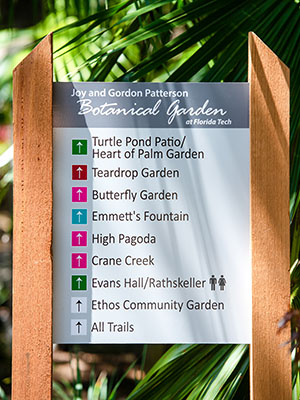Jungle Love
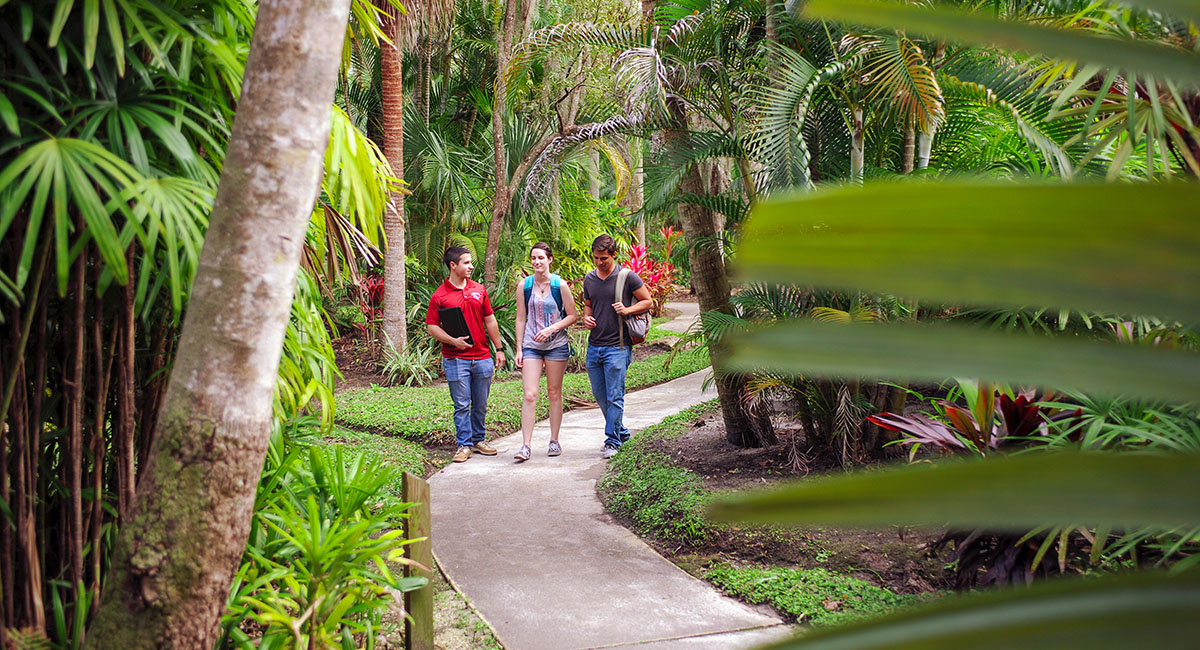
Cutting through The Jungle, as Florida Institute of Technology students call the school’s unusual botanical garden, makes for an interesting way to get to class. FIT PHOTOS
Florida Tech has a closely held secret garden
Florida Institute of Technology has a secret. A secret garden, that is.
The Joy and Gordon Patterson Botanical Garden has been there to wrap visitors in an oasis of calm, for decades. While it is not far geographically, it feels worlds away from traffic troubles, cell phone intrusion and all the other irritating trappings of life.
Nicknamed The Jungle by students for its abundant flora and fauna, this public garden encompasses 15 acres of prime campus real estate, bordering Babcock Street in the heart of the university’s Melbourne campus. It has weathered storms, development, freezes and neglect, but manages to prevail.
Its latest saviors are educators Joy and Gordon Patterson. Gordon — the personification of James Hilton’s Mr. Chips — is a long-beloved professor in the School of Arts and Communication at Florida Tech. Joy has also taught at Florida Tech as well as neighboring Melbourne Central Catholic High School. She is now a volunteer tutor at Florida Tech’s Student Success and Support Center. Five decades ago, the couple married at UCLA’s Mathias Botanical Garden. Their love for university gardens has never diminished.
“Our introduction to Florida Tech was a walk beneath these palms,” Gordon said. “Later, our son grew up playing here.”
In 2019, the Pattersons made a generous commitment to the future of The Jungle, prompting the school to rename the garden in their honor. Every week, the two can be seen puttering there or discussing a particular specimen with visitors.
“What makes our garden unique is that it is in a floodplain, with a lot of different ecological zones,” Gordon said.
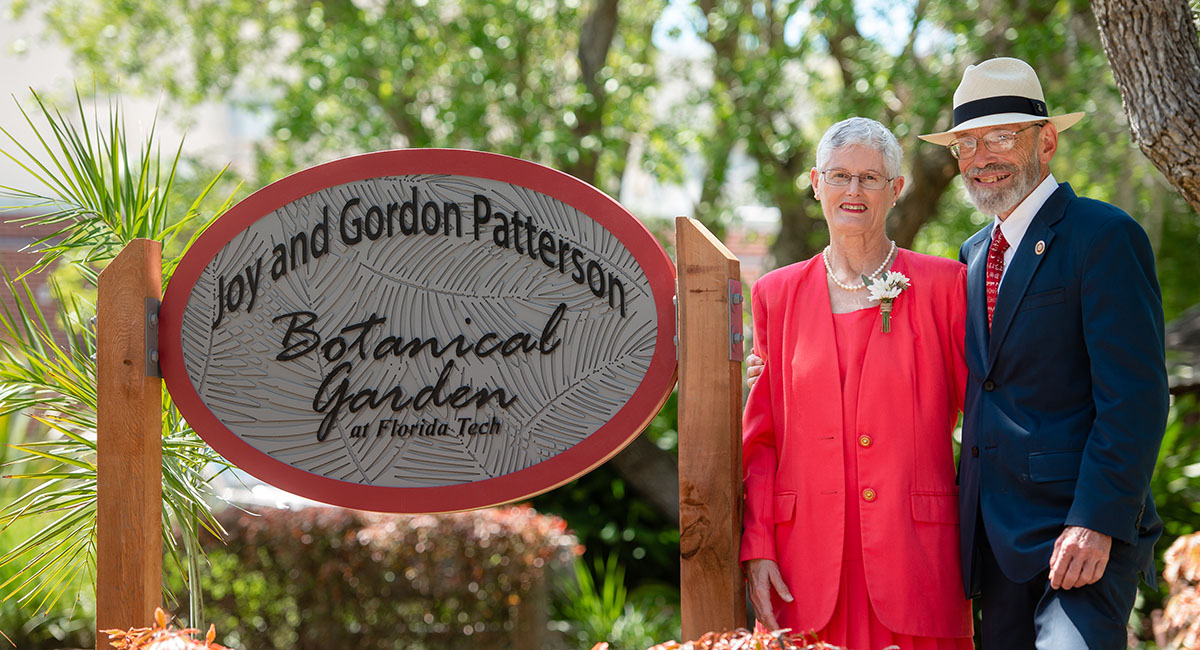
A generous gift from Joy and Gordon Patterson has revived Florida Tech’s botanical garden.
FOUNDERS AND KEEPERS
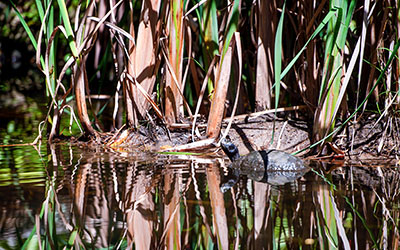
A turtle enjoys the sun at the university’s Joy and Gordon Patterson Botanical Garden.
The verdant lowland hammock of elm, oak and maple was part of the reason the school was granted its first 40 acres of the present campus in 1960.
“I believe the critical factor in our favor was my pledge to maintain the natural hammock that threaded through the property and to not disturb any of the trees unnecessarily,” wrote Florida Tech founder Jerome Keuper.
The dense canopy of trees in the floodplain of Crane Creek would serve as a greenhouse for the cold-sensitive plants that Keuper would later plant in the fertile soil.
Keuper, a rocket scientist, loved bowties, MG convertibles and palm trees. He embraced the opportunity to enhance the garden with palms.
Enter wealthy bond trader and palm fanatic Dent Smith, whom Keuper enlisted for help. Smith, founder of the International Palm Society, believed the hardwood hammock could house a world-class collection of palms. So, he had a truckload delivered along with a gardener to help plant them. Smith continued his support of the garden for years, helping to shape The Jungle into one of the most unique campus botanical gardens in the nation. The Dent Smith Trail, which winds its way through the hammock, acknowledges his contribution.
After he retired, Keuper spent his days in the garden, where the Pattersons would often join him. Since it is part of a university where technology reigns, Joy has helped install placards with QR codes that give information on different aspects and residents of the garden. Weather permitting, Gordon holds his office hours there, to entice his students to get outside. Joy has launched a student group — the Keuper Palm Botanical Society — to keep the garden in shape.
“We’re hoping we’re planting the seeds,” she said.
Slate Varn will graduate this year with a mechanical engineering degree from Florida Tech, in addition to four years of gardening experience. As vice president of the botanical society, Varn has both cultivated and been an advocate for the garden.
“I started in freshman year, when I saw there wasn’t a whole lot being done for the garden,” said Varn, who, appropriately enough, grew up in Plant City, Florida.
Last fall, students from the botanical society took incoming university President Dr. John Nicklow on a tour of the garden. They realized that its ultimate survival depends on continuing interest and support from the school’s policymakers.
“I want this to be in the DNA of the administration,” Gordon said.
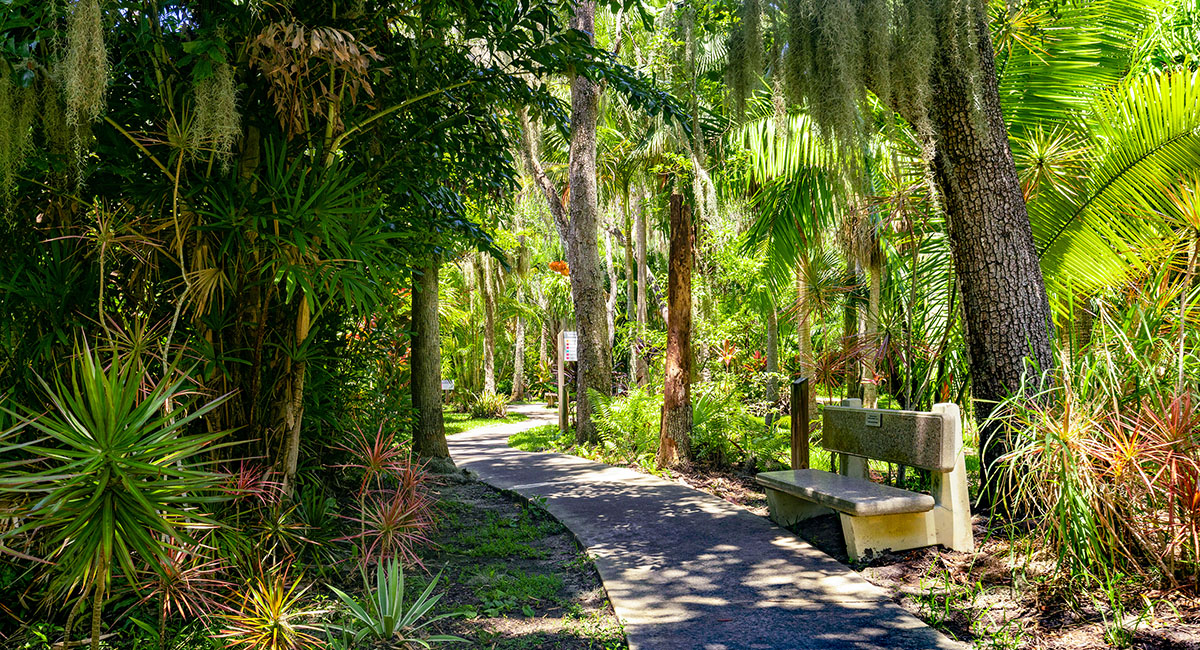
A network of trails meander through the Joy and Gordon Patterson Botanical Garden at Florida Tech. There is no need to rush here.
RARITIES
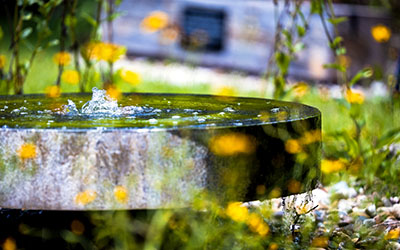
Water features add serenity to the botanical garden where professor — and garden advocate — Dr. Gordon Patterson prefers to hold office hours to entice students to enjoy the outdoors.
A stream meanders through more than 200 palms, bamboos and other often rare plant species. Palms from around the globe live in harmony here. Among the crisscrossing trails are specimens such as the buccaneer palm, once abundant in the Florida Keys but now endangered because of development. Like the buccaneer, bottle palms are threatened with extinction. A two-headed gingerbread palm is unusual looking, but branching of the trunk is a natural tendency in these species native to Central Africa.
Monarchs, zebra longwings and other species of butterflies regularly flit amidst the pollinator plants in the Butterfly Garden. The Turtle Pond is home to Florida softshell cooters, red-eared sliders and snapping turtles.
In compiling a database of campus wildlife, biology professor Dr. Mark Bush has discovered unusual species such as the ruddy daggerwing, a butterfly that usually favors more temperate climates. Great horned owls, marsh rabbits, otters and an occasional coyote inhabit the oasis.
The garden also serves as a “highway hotel” for birds migrating through the Atlantic Flyway.
“It’s an important feeding area for these migratory birds,” Bush said.
Because the garden provides such a photo op, it is often the site for weddings, graduation and prom pictures, as well as new baby snapshots. Through the years, the garden has endured ups and downs, but it prevails in its mission to be a place for peace and wellness. Bush welcomes any chance to bask in the garden’s zen.
“It’s a great place to gather your thoughts,” he said.
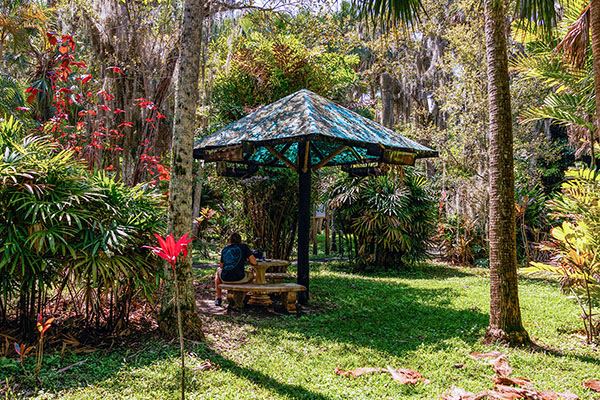
Florida Tech’s public garden encompasses 15 acres of prime campus real estate. In this oasis just steps from busy Babcock Street in Melbourne, peace prevails.
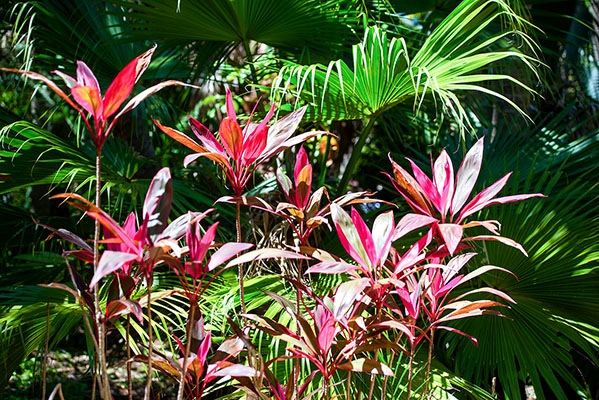
Native and exotic plant specimens call Florida Tech’s Joy and Gordon Patterson Botanical Garden home.
Joy and Gordon Patterson Botanical Garden
Located in the northeast part of the Florida Tech
campus, the garden is open from sunrise to sunset. Admission is free, with parking available in red-striped spaces in the garden adjacent to the parking lot off Babcock Street.
A self-guided walking tour map can be downloaded from fit.edu/garden. Begin the tour by Evans Library, across from the garden.
Foundation of learning
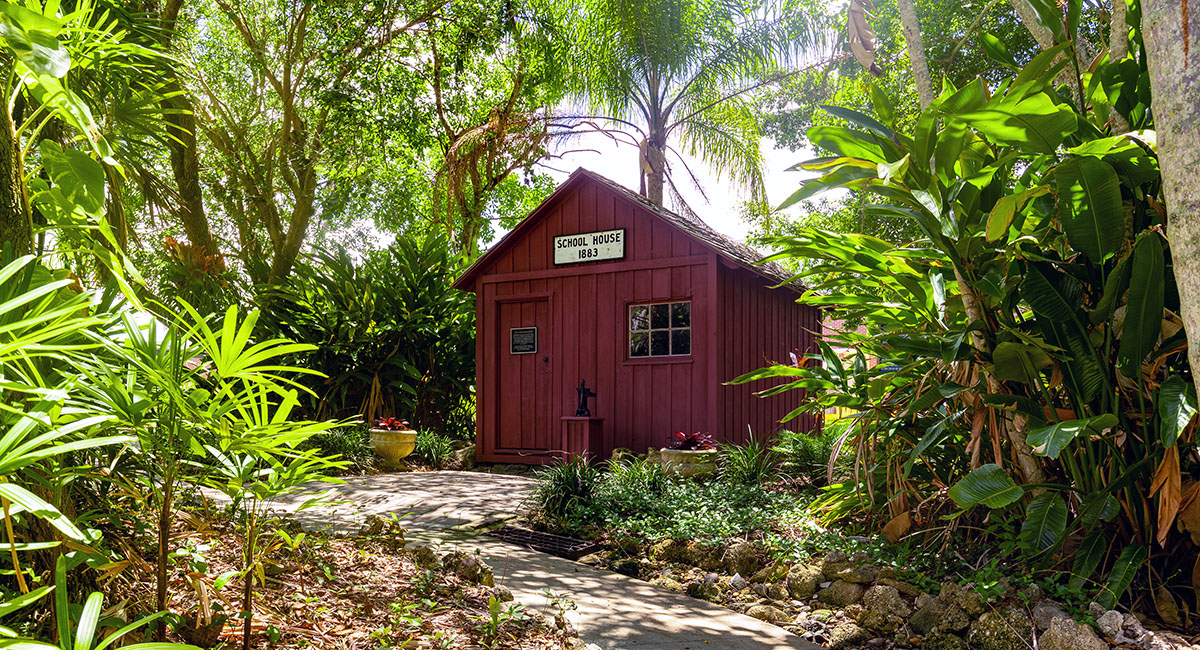
Melbourne’s original schoolhouse greets visitors to the Joy and Gordon Patterson Botanical Garden at Florida Tech. FIT
Melbourne’s original — and rather mobile — schoolhouse found its forever home at Florida Tech’s botanical garden.
The 10×12-foot Little Red Schoolhouse was originally built in 1883 on Riverside Drive, adjacent to U.S. Highway 1, in Melbourne. The tiny, one-room seat of learning was segregated, with white students attending in the morning and African American students in the afternoon.
Used for only six years before a bigger building replaced it, the schoolhouse experienced neglect for half a century until 1940, when it was restored and moved to the campus of the Ruth Henegar Elementary and High School complex in Melbourne. Shortly thereafter, the house moved once again — across Crane Creek, to house a family who had lost their home to fire.
In 1970, the schoolhouse made its final trip, to its present location at the entry to the university’s botanical garden. The story goes that the slabs of coquina rock that anchor the building were from an original University of Florida structure.
“The real foundation of engineering education in Florida is there,” Gordon Patterson said.

Maria Sonnenberg
Maria is a prolific writer and proofer for Space Coast Living and an adjunct professor at Florida Institute of Technology’s Nathan M. Bisk College of Business. When not writing, teaching or traveling, she can be found waging a one-woman war against her lawn and futilely attempting to maintain order among the chaos of a pack of extremely clueless wirehair dachshunds and an angst-driven basset hound.



